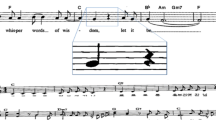Abstract
Optical music recognition (OMR), when the input music score is captured by a handheld or a mobile phone camera, suffers from severe degradation in the image quality and distortions caused by non-planar document curvature and perspective projection. Hence the binarization of the input often fails to preserve the details of the original music score, leading to a poor performance in recognition of music symbols. This paper addresses the issue of staff line detection, which is the most important step in OMR, in the presence of nonlinear distortions and describes how to cope with severe degradations in recognition of music symbols. First, a RANSAC-based detection of curved staff lines is presented and staves are segmented into sub-areas for the rectification with bi-quadratic transformation. Then, run length coding is used to recognize music symbols such as stem, note head, flag, and beam. The proposed system is implemented on smart phones, and it shows promising results with music score images captured in the mobile environment.



















Similar content being viewed by others
Notes
Demonstration of user interface: https://www.youtube.com/watch?v=lh5c9z-JaZg
References
Audiveris (2013) https://github.com/audiveris
Bellini P, Bruno I, Nesi P (2001) Optical music sheet segmentation. In: International Conference on WEB Delivering of Music. IEEE, Florence, p 183–190
Blostein D, Baird HS (1992) A critical survey of music image analysis. In: Structured Document Image Analysis, p 405–434
Bolles RC, Fischler MA (1981) A RANSAC-based approach to model fitting and its application to finding cylinders in range data. In: International Joint Conference on Artificial Intelligence, Vancouver, Canada, vol 2, p 637–643
Calvo-Zaragoza J, Vigliensoni G, Fujinaga I (2017) Pixel-wise Binarization of Musical Documents with Convolutional Neural Networks. In: IAPR Conference on Machine Vision Applications
Cardoso JS, Capela A, Rebelo A, Guedes C, Pinto da Costa J (2009) Staff Detection with Stable Paths. IEEE Trans Pattern Anal Mach Intell 31(6):1134–1139
Carter NP, Bacon RA (1992) Automatic Recognition of Printed Music. Structured Document Image Analysis, p 454–465
Cormarck AM (1963) Representation of a function by its line integral, with some radiological applications. J Appl Phys 34(9):2722–2727
Fujinaga I (2004) Staff Detection and Removal. Visual Perception of Music Notation, p 1–39
Hsu YN, Arsenault HH, April G (1982) Rotation-invariant digital pattern recognition using circular harmonic expansion. Appl Opt 21(22):4012–4015
ICDAR / GREC (2013) Competition on Music Scores. http://dag.cvc.uab.es/muscima/?page_id=11
Jacobi L (2011) SmartScore X Pro (review). PC World, London Accessed August 2013
Johnson M (2008) Finale 2008 Power. Penolope Press, New York, p 288
Kahan S, Pavlidis T, Baird HS (1987) On the recognition of printed characters of any font and size. IEEE Trans Pattern Anal Machine Intell 9(2):274–288
Kato H, Inokuchi S (1992) A recognition system for printed piano music using musical knowledge and constraints. In: Structured Document Image Analysis, p 435–455
Martin P, Bellissant C (1991) Low-Level Analysis of Music Drawing Images. Proc. First Int’l Conf. Document Analysis and Recognition, p 417–425
Nicholl, Grudzinski (2007) Music Notation: Preparing Scores and Parts, 1st edn. Berklee Press, Boston, p 110
Pinto T, Rebelo A, Giraldi G, Cardoso JS (2011) Music Score Binarization Based on Domain Knowledge. Lecture Notes in Computer Science book series (LNCS, volume 6669)
Randriamahefa R, Cocquerez JP, Fluhr C, Pepin F, Philipp S (1993) Printed music recognition. Proceedings of the second international conference on document analysis and recognition, p 898–901
Rebelo FI, Paszkiewicz F, Marcal ARS, Guedes C, Cardoso JS (2012) Optical music recognition: state-of-the-art and open issues. Int J Multimed Inf Retr 1:173–190
Reed KT, Parker JR (1996) Automatic computer recognition of printed music. In: International Conference on Pattern Recognition, vol 3. IEEE, Vienna, p 803–807
Sayood K (2002) Lossless Compression Handbook. Academic Press, Oxford
Soille P (1999) Morphological Image Analysis: Principles and Applications. Springer-Verlag, New York, pp 173–174
Spenillo C (2013) MakeMusic Releases Finale 2014. Business Wire, San Francisco
Su B, Lu S, Pal U, Tan CL (2012) An Effective Staff Detection and Removal Technique for Musical Documents. Proceedings of the 2012 10th IAPR International Workshop on Document Analysis Systems, p 160–164
Tang YY, Suen CY (1993) Image transformation approach to nonlinear shape restoration. IEEE Trans Syst Man Cybernet 23(1):155–172
Tang YY, Li ZC, Suen CY, Bui TD (1988) Conversion of Chinese characters by transformation models. In: Proc. Int. Conf Computer Processing of Chinese and Oriental Languages, p 293–297
Tard’on LJ, Sammartino S, Barbancho I, G’omez V, Oliver A (2009) Optical Music Recognition for Scores Written in White Mensural Notation, EURASIP Journal on Image and Video Processing 2009
VanDerBosch K (2009) MakeMusic, Inc. Releases Finale 2009: Finale’s 20th anniversary is celebrated with major workflow improvements (Press release)
Vo QN, Nguyen T, Kim SH, Yang HJ, Lee GS (2014) Distorted Music Score Recognition without Staffline Removal. In: Proc. Int. Conf on Pattern Recognition, p 2956–2960
Acknowledgements
This research was supported by Basic Science Research Program through the National Research Foundation of Korea (NRF) funded by MEST (NRF-2015R1D1A1A01060172 and NRF-2017R1A4A1015559).
Author information
Authors and Affiliations
Corresponding author
Rights and permissions
About this article
Cite this article
Vo, Q., Lee, G., Kim, S. et al. Recognition of Music Scores with Non-Linear Distortions in Mobile Devices. Multimed Tools Appl 77, 15951–15969 (2018). https://doi.org/10.1007/s11042-017-5169-9
Received:
Revised:
Accepted:
Published:
Issue Date:
DOI: https://doi.org/10.1007/s11042-017-5169-9




